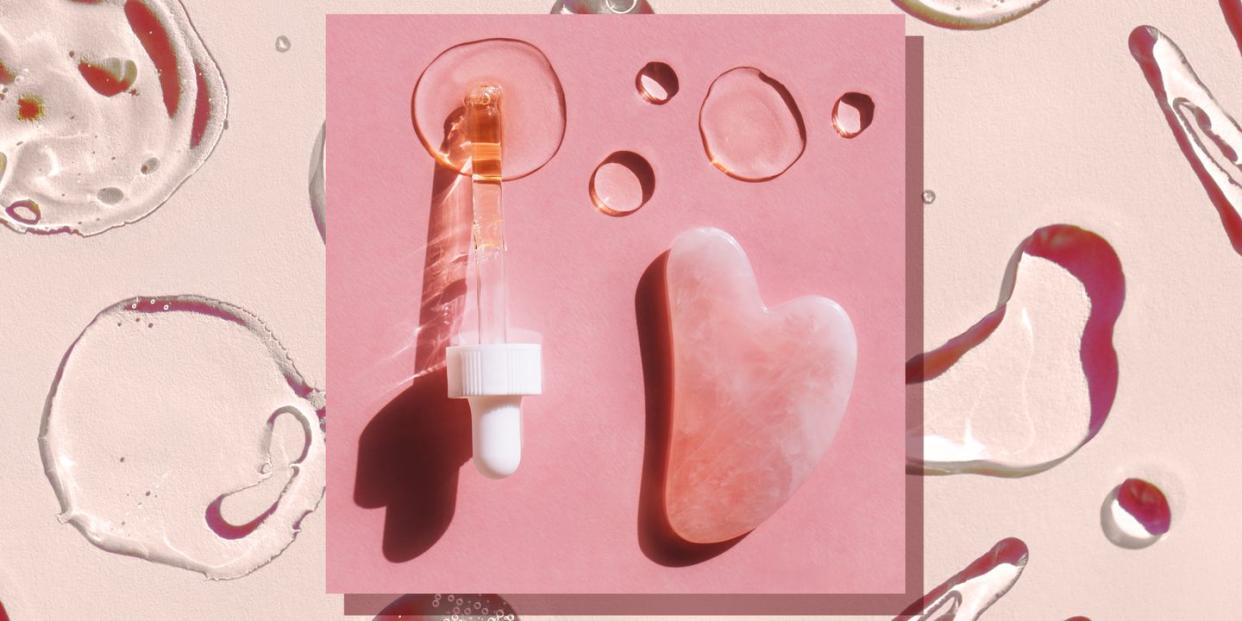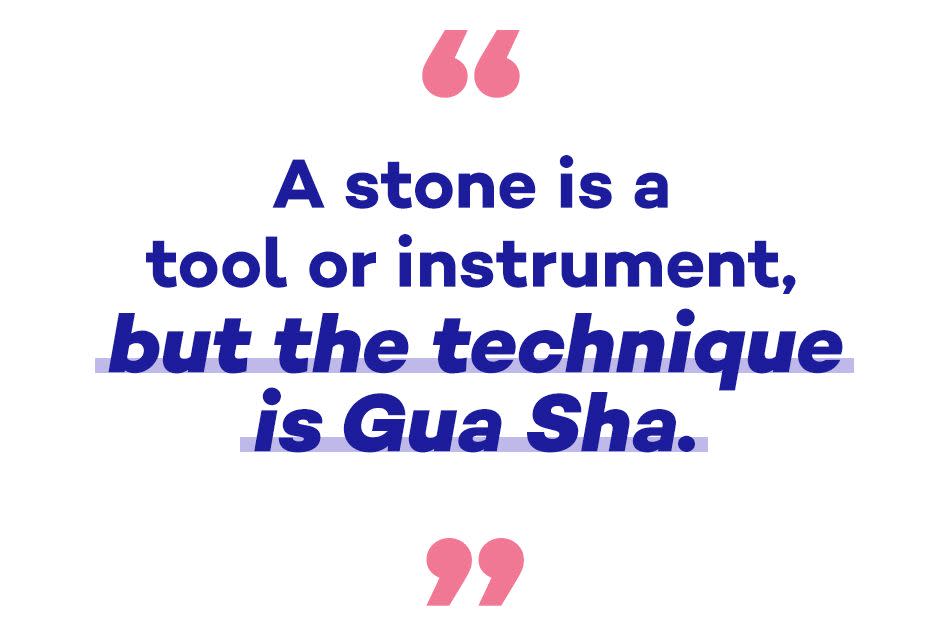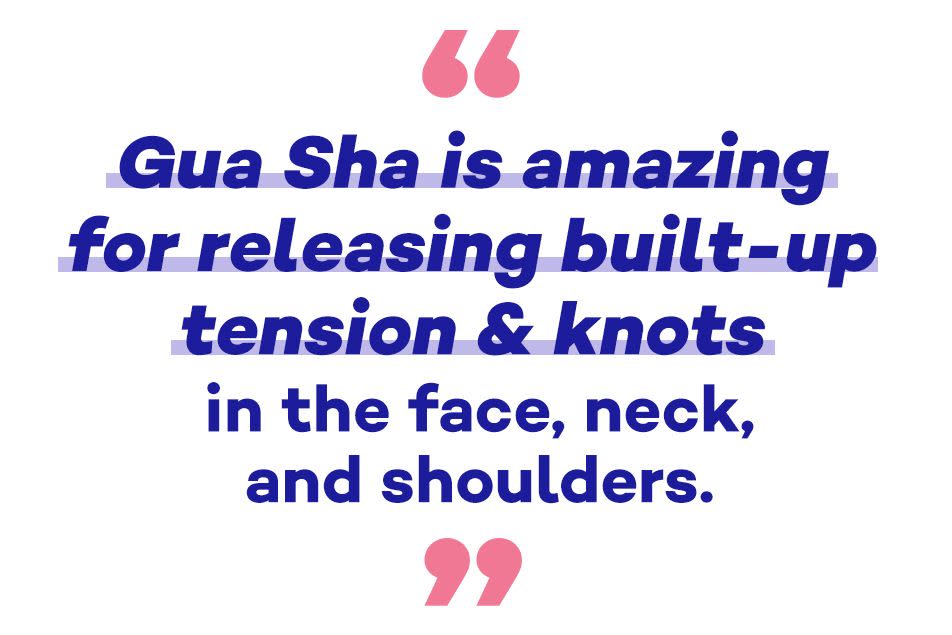Read This if You’ve Ever Been Curious About Gua Sha

By now, you've probably heard about the wonderful benefits of at-home facial massages, but in case you need a refresher, here are a few. Think: anti-aging, reduced acne, improved blood flow in skin, the list can go on and on.
But if your hands aren't doing the job for you, then it's time to bring in some tools. One of our favorite tools for giving our face a deep massage is the famous gua sha, an oblong-shaped stone that's been used in ancient Chinese beauty and health rituals for centuries.
What Is Gua Sha?
According to Sandra Lanshin Chiu, licensed acupuncturist, herbalist, and founder of Lanshin, gua sha is actually a traditional Chinese medicine (TCM) practice most commonly used to treat pain, but also useful for some internal conditions.

Lanshin would also like to debunk this extremely common misconception: Gua sha is a technique, not a singular product. She notes that many materials are used as gua sha tools, but stones such as jade or rose quartz are the most common for cosmetic applications like facial gua sha.
As for the actual practice of gua sha, the treasured technique involves using a tool (traditional gua sha often involves the use of a coin or a porcelain soup spoon, according to Lanshin) to stroke or “scrape” tight, tense, or pathological areas to break down and remove blood stagnation.
“Gua sha improves the circulation of blood, fluids, and qi (energy), and modern research confirms that it strengthens the immune system and has powerful anti-inflammatory effects,” says Lanshin.

Though gua sha can be practiced on the entire body, facial gua sha has become increasingly popular around the globe. However, Lanshin notes that this extension of the TCM practice differs significantly in both application and results.
While gua sha is traditionally more aggressive, Lanshin notes that facial gua sha uses a much gentler, softer touch. Pressure varies depending on the area of the face and neck, but for self-care, Lanshin recommends light-to-medium pressure, and always feather-light around the eyes. "When in doubt, the face really responds to a ‘less is more’ approach,” she says.
What Are the Benefits of Practicing Facial Gua Sha?
According to Lanshin, there are a plethora of benefits that come from practicing gua sha on your face. She says that when practiced correctly, facial gua sha stimulates and improves circulation of blood, fluids, and qi in the skin and underlying tissue.
{{ this.render( "@app/views/shared/embed-accessibility-text.twig", { embedName: "Instagram", })|raw}}

“In TCM, a constant flow of circulation is what keeps your body healthy and gives skin its glow,” she says. “Improved circulation creates visible changes including but not limited to reduced puffiness, smoother complexion, softened lines, reduced sagging, sculpted and lifted appearance, added volume (something we lose with age), and it can even help acne heal faster.”
As another added bonus, Lanshin says facial gua sha is also amazing for releasing built-up tension and knots in the face, neck, and shoulders. "Many of the benefits are immediate, making it an ideal DIY technique for jaw pain (like TMJ), headaches, seasonal allergies, and sinus congestion," she says.

However, Lanshin would like to note that you should avoid practicing gua sha on inflamed, open, or picked skin. Instead, she suggests covering any of these problem areas with a hydrocolloid pimple patch or avoid until it heals.
Tips for Practicing Facial Gua Sha at Home
So, want to reap all of the benefits of this treasured Chinese practice? Before you start massaging your face with your favorite gua sha tools, Lanshin has a few tips for you to follow:
Don’t store your facial gua sha tools in the fridge or freezer: “In TCM we generally avoid using cold tools on the skin and body because cold constricts circulation,” Lanshin advises. “In fact, for most age-related concerns, as well as acne and skin congestion, I use a room temperature or warm tool to stimulate circulation, creating optimal conditions for healing and rejuvenation. I’m not saying a chilled tool will hurt you, but it’s not used in TCM.”
Any time is a great time to practice gua sha: Lanshin says that the best time to practice facial gua sha is when it’s convenient and realistic for you. “Some people enjoy it in the morning to energize, others prefer it as a relaxing ritual before going to sleep,” she says. “A quick facial gua sha session is my favorite way to prep skin before putting on makeup.”
Don't forget to prep your skin first: Before you start practicing gua sha on your face, Lanshin advises “prepping” your skin first with a hydrating mist or alcohol-free toner. She also recommends following up with a facial oil formulated for your skin type. “You need enough to get the necessary ‘glide’ and avoid dry friction,” she says. “A concern I often hear from those with oily or acne-prone skin is that using facial oil could cause breakouts, but you can hear my take on that here.”
Slow and steady wins the race: Lanshin says that using slow, gentle strokes and light to medium pressure is key when practicing facial gua sha. She notes that going too hard or too fast may result in “Sha,” or temporary red marks that look similar to a hickey.
Purchase your tool from a TCM practitioner: If possible, Lanshin recommends sourcing your gua sha tools from a TCM practitioner, such as a licensed acupuncturist. “As gentle as facial gua sha is, it’s a medical practice with contraindications and potential risks,” she says. “Brands that sell gua sha tools should provide customer support informed by firsthand clinical experience and education, more than a weekend course or 2-week training. My inbox is full of questions from consumers who purchased a tool, only to realize after the fact that there’s no one at the brand who can provide the informed, experienced support needed.”
Learn the facial gua sha technique: As we said before, gua sha is a practice that needs to be, well, practiced. If you’re looking for a place to start, Lanshin has free tutorials for you to check out. “If you follow along two or three times, it’ll take 20-25 minutes to learn my technique and basic routine,” she says. “It’s actually pretty simple and repetitive so once you know the steps it takes about 10 minutes. You can always refer back to my videos for touch-ups, or find me on Instagram if you have questions!"
As Lanshin advised, you should really consult with a TCM practitioner before buying a gua sha tool in order to get the best benefits. However, if you can't access a trusted TCM practitioner in your area, we recommend following along with Lanshin's tutorials and grabbing a trusted gua sha tool for yourself.
That's where we come in: Our beauty editor has tried and tested out facial gua sha tools for years, and the following are her absolute favorites for giving her face a deep at-home gua sha massage. Plus, she’s not the only fan of these tools: Shoppers have given these gua sha tools sparkling reviews on major retailers like Sephora, Amazon, and more.
However, the most important issue to us is proper representation. Yes, there are tons of gua sha tools on the market, but cultural appropriation is rife within the gua sha tool market, and we'd rather work to change that. Every single one of these facial gua sha tools is created by AAPI-owned beauty brands, so you're giving back to the community that created this revolutionary facial massage treatment.
The Best Facial Gua Sha Tools
Best Overall
OK, so I know this one is pricey, but it's truly the best gua sha tool you could ever find on the market. First off, it's created by Lanshin, who's extremely well-versed in the art of gua sha, and she used that expertise to create the ultimate gua sha device.
It's made out of sturdy dark-green nephrite, which glides on the skin without excessive pulling or tugging, which only works even better when paired with your favorite oils. It also has three smooth, rounded edges — the larger edges are for the contours of your face, and the smaller one is for your eye area — and a ridged edge for a deeper gua sha treatment.
Best Jade Gua Sha Tool
This facial gua sha tool is made out of Xiuyan jade, which feels cool and soothing on skin without any need to pop it into your skincare fridge (which Lanshin advises against doing). It also has rounded edges and a slim stature to get into every nook and cranny of your face. This lightweight gua sha tool is also the easiest one to use, making it the best pick for beginners and gua sha enthusiasts alike.
Best Metal Gua Sha Tool
If you want a heavier feel to your gua sha tools, then allow me to introduce you to this stainless steel option from Sacheu. Its heavier feel makes it perfect for a deeper treatment, and it's also super easy to clean: Just wash off with soap and water, and you're all set for your next gua sha session.
Best for Body
We love a good facial gua sha stone, but this particular one was crafted to use from the neck down. Soothe your tensest muscles with this oblong-shaped gua sha stone, which is made out of bian stone and crafted by doctors of Chinese medicine to give you the ultimate experience. Its varying edges help get into the deepest contours of your body, so you'll feel like you just had a deep tissue massage after one session with this soothing stone.
Retains Warmth
As Lanshin said before, traditional gua sha techniques are practiced with warm tools. So, if you'd rather take a more traditional route with your gua sha routine, then we recommend grabbing this black obsidian tool. You can soak the stone in hot water for a few minutes, pop on a sheet mask, and then glide the stone against the sheet mask to improve product absorption. Its versatile comb shape also offers four massage touch points and the flat surface is great for pressing against a sheet mask to help boost warmth and serum absorption.
Cool Shape
This gua sha stone's cloud-like shape isn't just for looks: Its shape allows the stone to massage just about every contour on your face. It allows you to take a truly customizable approach to your gua sha routine so you can target any of your skin and muscle issues with ease. Its multitoned rainbow fluorite stone hue also makes this gua sha tool a very Insta-worthy skincare tool.
Best Gua Sha Spoon
We love this gua sha spoon for getting a deeper massage experience. Its slim rose quartz body makes it perfect for digging into any knots and problem areas. You can use the larger bulbous head for a general massage, and the smaller tapered end for pinpointing any sore muscles, knots, and smaller areas of the face.
You Might Also Like

